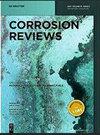中性含氟水介质中硝基-三(亚膦酸)锌对低碳钢的缓蚀效果及机理研究
IF 3.2
4区 材料科学
Q3 ELECTROCHEMISTRY
引用次数: 0
摘要
摘要采用动电位极化和深度剖面XPS分析方法,研究了在含F -离子硼酸盐缓冲溶液(pH = 7.4)中,添加ZnNTP和不添加ZnNTP作为缓蚀剂(NTP = N(CH 2 PO 3) 3) 3时,e235钢在pH = 7.4硼酸盐缓冲溶液中的腐蚀电化学行为。根据施加电位的不同,F离子对钝化膜的形成、组成和结构有不同的影响。在E <在0.1 ~ 0.2 V/SSCE范围内,F−离子通过形成稀溶fef2促进钝化,形成的膜主要由铁(II)氧化物和氢氧化物以及稀溶fef2和FeZnNTP组成。在E >在0.1 ~ 0.2 V/SSCE中,Fe -离子与Fe - 3+离子形成可溶化合物,破坏了钝化膜,导致钝化膜变薄。ZnNTP抑制剂与铁离子形成FeZnNTP异质金属配合物,是钝化膜中最稳定的成分。当F−离子浓度不超过1.4 mmol/L时,ZnNTP抑制剂的最佳添加量为0.5 ~ 1.0 g/L,而当F−离子浓度大于5.6 mmol/L时,则需要添加5 g/L甚至更多的ZnNTP。本文章由计算机程序翻译,如有差异,请以英文原文为准。
Inhibition efficiency and mechanism of nitrilo-tris(methylenephosphonato)zinc on mild steel corrosion in neutral fluoride-containing aqueous media
Abstract Corrosion-electrochemical behaviour of steel E 235 in borate buffer solution (pH = 7.4) containing F − ions with and with no added ZnNTP as an inhibitor, where NTP = N(CH 2 PO 3 ) 3 , was studied by the potentiodynamic polarization and depth-profiling XPS analysis of specimens polarized at different potentials applied. Depending on the potential applied, F − ion was shown to influence differently on the formation, composition and structure of passive film. At E < 0.1–0.2 V/SSCE, F − ion promotes the passivation via forming sparingly soluble FeF 2 , and the resulting film is comprised of mainly iron(II) oxides and hydroxides, as well as sparingly soluble FeF 2 and FeZnNTP. At E > 0.1–0.2 V/SSCE, F − ion works for the destruction of the passive film by forming soluble compounds with Fe 3+ ions, which leads to its thinning. ZnNTP inhibitor forms FeZnNTP heterometallic complex with iron ions, which is the most stable constituent of the passive film. When F − ion concentration does not exceed 1.4 mmol/L, ZnNTP inhibitor is optimal to be added in amount of 0.5–1.0 g/L, whereas concentrations of 5.6 mmol/L F − ion and higher require 5 g/L ZnNTP or even more to be added.
求助全文
通过发布文献求助,成功后即可免费获取论文全文。
去求助
来源期刊

Corrosion Reviews
工程技术-材料科学:膜
CiteScore
5.20
自引率
3.10%
发文量
44
审稿时长
4.5 months
期刊介绍:
Corrosion Reviews is an international bimonthly journal devoted to critical reviews and, to a lesser extent, outstanding original articles that are key to advancing the understanding and application of corrosion science and engineering in the service of society. Papers may be of a theoretical, experimental or practical nature, provided that they make a significant contribution to knowledge in the field.
 求助内容:
求助内容: 应助结果提醒方式:
应助结果提醒方式:


